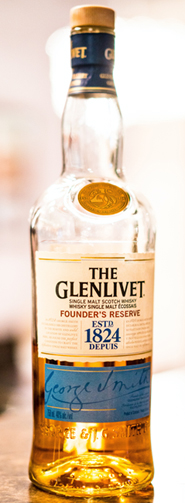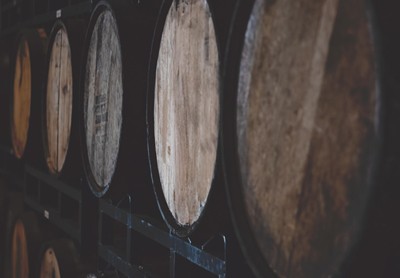Whiskey. Or is it Whisky? We’ve all heard of it, but how is it spelt? Where did it come from? Both questions seem to have conflicting answers. What exactly is the difference between Scotch Whisky and Irish Whiskey? This article will address such questions and get to the bottom of the mystery of this famous spirit.
What is Whiskey?
Whiskey/whisky is the alcoholic spirit beverage that results from distilling fermented grain mash, then storing for a time in wooden barrels with charred insides to soften and adopt certain desired flavors and aromas. American Oak tends to be the preferred wood used for the aging barrels, or casks, as it boasts a tight grain which has found to be excellent at slowly releasing tannins.
Whisky or Whiskey, Why the Two Spellings?

Whiskey or Whisky? With or without the E? That is the question. The etymology of the word has its roots in the Irish and Scottish Gaelic words for water, uisce and uisge respectively. When anglicized, you get the word whiskey/ whisky. The spelling is much debated, some believing that the differing spellings should be used to identify the specific drink in hand. Others acknowledge the Chinese whispers of it all, knowing there is often differences and variation when it comes to how a word is spelt as it is handed down over the centuries. The truth is, like the spelling of words such as colour/color, the spelling of whiskey/ whisky has been used interchangeably, but in general terms whiskey with an E tends to be used to refer to the drink made in Ireland or the United States, while whisky without the E has been used for the drink made anywhere else in the world. The Scots label their drink ‘Scotch Whisky’ and in America this is often referred to simply as ‘Scotch’ - thus avoiding the spelling issue altogether - although in Scotland they refer to it as just ‘whisky’. For the purposes of this article, we will use the E. For the absolutist reader among us, it may be of interest to consider where whiskey originated to begin with.
Where did Whiskey Originate?
There is again some debate among connoisseurs as to the place of origin, and for good reason. Many will agree that it originated with the Celts around 1000 years ago but as to the specifics, things get a little fuzzy. The Irish will tell you they were first, and the Scots of course will disagree.
The current proof we have in written form shows that whiskey, or aqua vitae (spirited water in Latin) as it was then called, was mentioned in a Scottish record called the Exchequer Rolls that a certain Friar John Cor should have some ‘8 bolls’ of malt to make said beverage in 1494.
However, the first Irish written record predates this some 90 years. In 1405 in the Annals of Clonmacnoise, a chieftain by the name of Richard Magrannel is said to have expired as a result of consuming an excessive amount of ‘aqua vitae’ at Christmas. So, according to the written evidence available it would certainly seem that whiskey originated from Ireland some time before the 15th century A.D. But what of the distillation technology that makes the creation of whiskey possible in the first place? Should the inventors of distillation not be credited also?
A Brief History from Distillation to Whiskey
Distillation is the process of heating a substance for the purpose of separating certain desired components of that substance, due to differences in boiling points. By heating fermented materials for example, alcoholic liquor can be separated and then used for various purposes. The word distillation comes from the latin for drip down, ‘de-stillare’, which is descriptive of a liquid being separated from a substance via the processes of heating, evaporation and condensation.
It is believed that the process of distillation may date as far back as 1200 B.C.E with the Babylonians of ancient Mesopotamia, who used a rudimentary form of distillation to produce perfumes and balms. Tablets exist from this time period that describe primitive distillation processes, proving some form of distillation technology has been known for over 3000 years.
In 800 B.C.E the Chinese were busy distilling a beverage from rice. There is mention in records of the Romans producing a distilled beverage in 100 A.D.
We know that knowledge of this technology reached the Greeks in Alexandria around this time and by the fourth century distillation was mentioned by Aristotle when he talked of desalination of seawater, at the same time acknowledging that the process could also be applied to alcoholic beverages.
Around the time of the 8th Century distillation techniques and technology knowledge had spread from the Alexandrian Greeks to the Arabs and the process had begun to improve. By the 10th century An Arab by the name Ibn Yasid had started to use an apparatus called an alembic to obtain alcohol. In the 12th century medieval Latins had begun to record distillation and by the 13th century records show alcohol was being distilled from wine in Italy.

Europeans of old began adopting these practices with their own products of the vine, beginning the long-standing French obsession with brandy. They would also distil honey to make an alcoholic beverage by the name of mead. These distilled spirits are more on the sweet side, due to the natural sugar content of honey and grapes. Meanwhile, travelling monks are largely credited with the spread of the knowledge and techniques of distillation in the following centuries from Arabia throughout mainland Europe and into Ireland and Scotland.
Where the plentiful grapes of mainland Europe had been used to distil in the likes of Italy and France, these were not so readily available in places like Scotland and Ireland, so instead they turned to what was largely available to them -grain. Fermented grain mash was then distilled and resulted in the first early samples of what we now recognize today as whiskey.
These early forms of whiskey weren’t the smooth drink we know today, in fact some references show this was occasionally referred to as ‘fire-water’ (perhaps we can identify with this characterization had we ever taken a sip of Dad’s whiskey as a child). Eventually the art of maturing developed, and with it the varied delights and flavors that capture the attention of whiskey lovers worldwide.
Irish Whiskey vs Scotch Whiskey, What’s the Difference?
So, is there any real difference between Irish Whiskey and Scotch Whisky, besides the spelling? Now we have considered proof that Irish Whiskey is older, does that mean it’s better? Are there any differences in how the two are made?
Scotch Whisky
Scotch whisky, in general, is distilled anywhere from twice to up to twenty times! As a rule, for it to be called Scotch whisky, it must have been matured for at the very least three years in oak casks and absolutely must be distilled in Scotland. Scotch whisky is usually from malt or grain then mixed to create whisky blends. Any age statement on a bottle of Scotch Whiskey in numeric form must reflect the age of the youngest whiskey used in that blend recipe, meaning the average age of a blended scotch may be in fact much higher than the label indicates.
The Scotch Whisky Association recognise five regions that Scotch Whisky is divided into, each having unique qualities and flavour, making blind whisky tastings rather fun in Scotland, the challenge being if you can identify whether your whisky came from Campbeltown, Speyside, Islay, Lowland, and Highland.
Irish Whiskey

Like Scotch whisky, Irish Whiskey absolutely must be produced in Ireland in order to bear the name, and by law must also be ‘matured’ or aged in casks for a minimum of three years.
Irish whiskeys are usually matured in the range of 9-12 years, despite the minimum age requirement.
Irish whiskey is usually made from unpeated malt and can be found in single malt or grain, blended, or single pot still whiskey. Irish whiskey is distilled in old-fashioned pot stills, but column stills are used for grain whiskey that is then mixed for blended whiskey. The whiskey is normally distilled three times, which is less than the average Scotch.
There are differences in the processes involved in the making of Scotch whisky and Irish whiskey and, of course, location of ingredients, but the only way to tell if this makes a difference to your taste buds is simply to try them all!
How Old is my Whiskey? What Does the Number on the Bottle Really Mean?
The number on a bottle of whiskey refers to, not the price (sadly) but how long it has been aged, or matured for. The clock starts ticking on the age of a whiskey the moment it is sealed in the chosen wooden cask. This is done to alter the flavour and smoothness of the spirit, as well as adding the pleasing caramel colour. Unlike alcoholic beverages such as wine, the best whiskey is not necessarily the eldest, although they may be more expensive due to their rarity and therefore collectible nature. Evidence suggests that for upwards of 20 years maturing in the cask, there is little improvement to the spirit left to be accomplished. Casks are made from oak, and sometimes pre-used to age other spirits. This allows for even more variation in flavour. American oak imports differing flavours to a French oak for example, and a French oak cask that has previously held rum will import yet more varied flavours to excite the palette. The flavouring possibilities are practically endless.
Maturing
Before the whiskey has been matured, the clear spirit obtained from the process of distillation has a raw and harsh ‘flavor’, if it can be called that. It is essentially flavouless ethanol at this point. Very sensitive palettes may be able to discern between pre-matured spirits based on location of distillation, however it is mostly after this point that the scent, colour and most importantly taste of the whiskey is decided, based on what kind of cask it is stored in for the next three to twenty years.
More Fun Facts about Fire Water
The French were all about brandy at first and had succeeded in making brandy popular in other countries, but due to being plagued by pests many vineyards were devastated by 1880, the French brandy industry took a back seat and whiskey soon overtook brandy in the marketplace.
Monks first administered early whiskey (also known as aqua vitae or ‘water of life’) for medicinal purposes with some success (the success being that it made people feel positively delightful and at this time in history this was tantamount to something being ‘good for the health’). Thus, the practice became known to other medical professionals at the time, so whiskey was obtained from either a monk or a doctor. It wasn’t until Henry the 8th took action to dissolve the monasteries that whiskey began to be produced in a home setting. The monks were reintegrated into the general populace and would thereafter make whiskey and sell it to support themselves.
In Scotland whiskey was known by another name for a time, when malt started to be taxed heavily in 1725. The taxation caused many Scots to produce whiskey overnight, to keep the smoke from the distillation process from being detected. The overnight whiskey was known for this reason as moonshine. Moonshine was hidden in churches and even in coffins so as to avoid detection! Nowadays, Scotland is home to more than 20 million casks of maturing whisky. That’s almost four for every person living there!
In the United States of America from 1920-1933, alcohol was banned from being sold, a time period now referred to as the Prohibition Era. The only exception was via prescription from your doctor and collection from a licensed pharmacy. For some reason pharmacies began popping up all over the place, Walgreens Pharmacy chain in particular grew from around 20 to around 400 stores in this time period!


